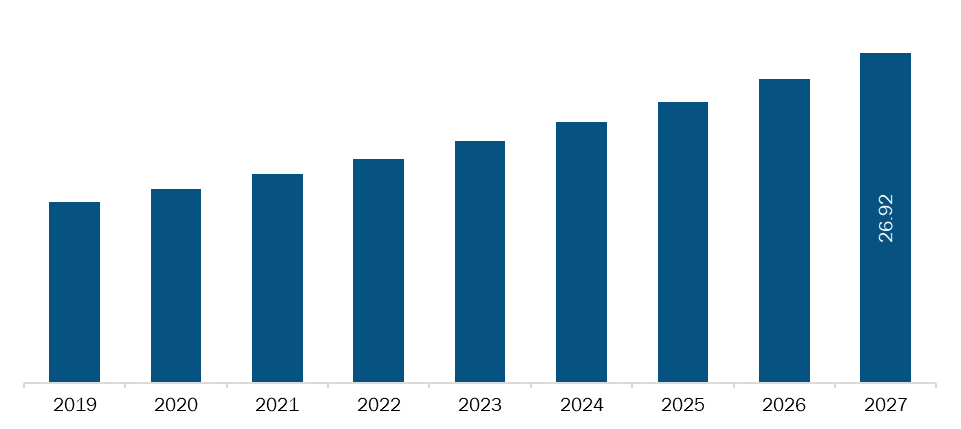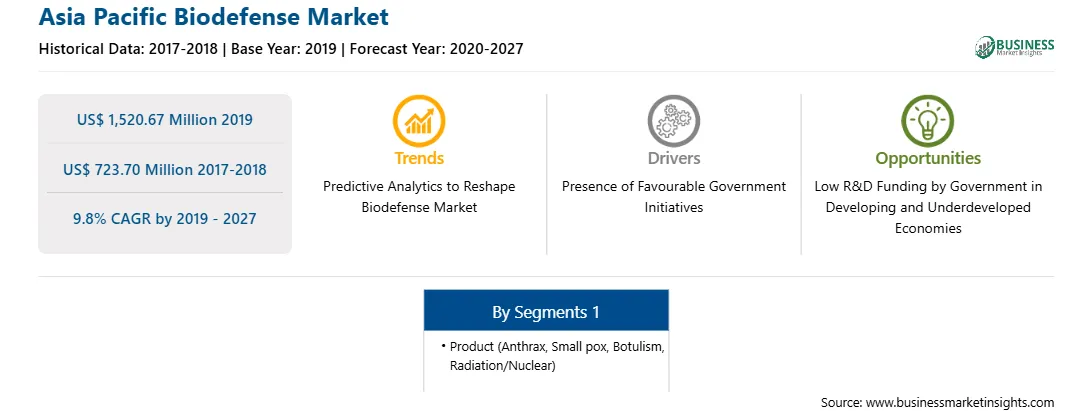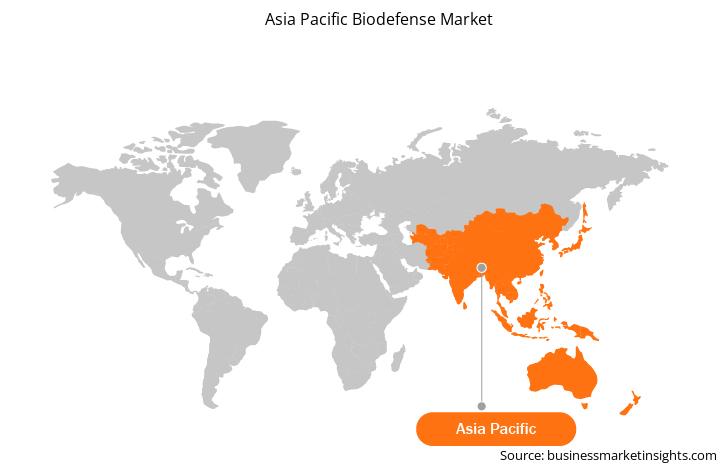The Asia Pacific Biodefense market is expected to reach US$ 723.70 Mn in 2027 from US$ 1,520.67 Mn in 2019. The market is estimated to grow with a CAGR of 9.8% from 2019-2027.
The growth of the Biodefense Market is driven by factors such as the favorable government initiatives increase in the number of naturally occurring outbreaks, increasing threat of biological weapons and nuclear armed ICBM in the Asia Pacific region. However, low R&D funding by government in developing and underdeveloped economies is likely to restrain the market growth to a certain extent.
Biodefense is referred to the measures taken to restore biosecurity of a group of organisms that are, or may be, subject to biological threats or infectious diseases. It is an effective public health care system with strong disease surveillance and rapid actions designed to counter biological threats, to limit the spread of disease and provide surge medical care.
Disease outbreaks of emerging infectious diseases are infections that have recently appeared within a population and are rapidly increasing or threaten to grow shortly. The SARS 2002-2003 epidemic appeared in November 2002 in the Guangdong province of southern China. This area is considered as a potential zone of re-emergence of SARS-CoV. Again, Human infections with an Asian lineage avian influenza A(H7N9) virus (“Asian H7N9”) were first reported in China in March 2013. The growing prevalence of Ebola and Zika virus infections is also likely to contribute to the market development. On 15 January 2020, the Ministry of Health, Labour and Welfare, Japan (MHLW) reported an imported case of laboratory-confirmed 2019-novel coronavirus (2019-nCoV) from Wuhan, Hubei Province, China. As of 30 March, 2020 Japan, reported 1,866 confirmed cases along with 74 deaths. Further, as of April 2020, China has approved three COVID-19 vaccine submissions for clinical trials, state-run Xinhua news agency quoted a Ministry of Science and Technology official.
The release of pathogenic agents such as anthrax or smallpox, biological toxins, chemical weapons such as nerve gas, or radioactive substances caused public threats in the past. In order to prevent such outbreaks, the government has planned various strategies. The growing prevalence of infectious diseases, such as coronavirus, Ebola and zika virus, is likely to boost the investments in the field of biodefense, thereby driving the Biodefense Market growth.
Biological weapons (BWs) deliver toxins and microorganisms, such as viruses and bacteria, so as to intentionally inflict disease among people, animals, and agriculture. Biological attacks can result in destruction of crops, temporarily discomforting a small community, killing large numbers of people, or other outcomes. Biological weapons have a long history of use. In 1346, the invading Tartar army catapulted the bodies of plague victims into the Crimean Peninsula city of Kaffa and infected its citizens. In 1763, British troops under General Jeffrey Amherst gave the Delaware Indians blankets used by people with smallpox, possibly infecting the susceptible native population. Japan contaminated food and released plague-infected ticks during their conflict with China during World War II. Although recent advances in biotechnology have made it easier to develop dangerous viruses, bacteria, and toxins with fewer resources. This has increased concerns that individuals and groups could resort to bioterrorism to attack a population. Hence, as the threat for biological weapon and nuclear armed ICBM is increasing, governments of various countries are actively funding for biodefense, thereby, positively propelling the Asia Pacific Biodefense Market.

Strategic insights for the Asia Pacific Biodefense provides data-driven analysis of the industry landscape, including current trends, key players, and regional nuances. These insights offer actionable recommendations, enabling readers to differentiate themselves from competitors by identifying untapped segments or developing unique value propositions. Leveraging data analytics, these insights help industry players anticipate the market shifts, whether investors, manufacturers, or other stakeholders. A future-oriented perspective is essential, helping stakeholders anticipate market shifts and position themselves for long-term success in this dynamic region. Ultimately, effective strategic insights empower readers to make informed decisions that drive profitability and achieve their business objectives within the market.

| Report Attribute | Details |
|---|---|
| Market size in 2019 | US$ 1,520.67 Million |
| Market Size by 2027 | US$ 723.70 Million |
| Global CAGR (2019 - 2027) | 9.8% |
| Historical Data | 2017-2018 |
| Forecast period | 2020-2027 |
| Segments Covered |
By Product
|
| Regions and Countries Covered | Asia-Pacific
|
| Market leaders and key company profiles |
The geographic scope of the Asia Pacific Biodefense refers to the specific areas in which a business operates and competes. Understanding local distinctions, such as diverse consumer preferences (e.g., demand for specific plug types or battery backup durations), varying economic conditions, and regulatory environments, is crucial for tailoring strategies to specific markets. Businesses can expand their reach by identifying underserved areas or adapting their offerings to meet local demands. A clear market focus allows for more effective resource allocation, targeted marketing campaigns, and better positioning against local competitors, ultimately driving growth in those targeted areas.

ASIA PACIFIC BIODEFENSE MARKET– MARKET SEGMENTATION
Asia Pacific Biodefense Market – By Product
Asia Pacific Biodefense Market – By Country
Companies Mentioned
The List of Companies - Asia Pacific Biodefense Market
The Asia Pacific Biodefense Market is valued at US$ 1,520.67 Million in 2019, it is projected to reach US$ 723.70 Million by 2027.
As per our report Asia Pacific Biodefense Market, the market size is valued at US$ 1,520.67 Million in 2019, projecting it to reach US$ 723.70 Million by 2027. This translates to a CAGR of approximately 9.8% during the forecast period.
The Asia Pacific Biodefense Market report typically cover these key segments-
The historic period, base year, and forecast period can vary slightly depending on the specific market research report. However, for the Asia Pacific Biodefense Market report:
The Asia Pacific Biodefense Market is populated by several key players, each contributing to its growth and innovation. Some of the major players include:
The Asia Pacific Biodefense Market report is valuable for diverse stakeholders, including:
Essentially, anyone involved in or considering involvement in the Asia Pacific Biodefense Market value chain can benefit from the information contained in a comprehensive market report.